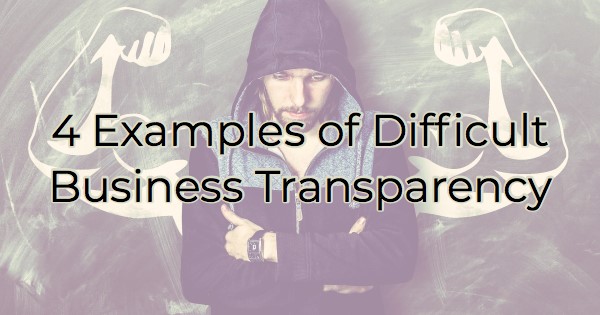4 Examples of Difficult Business Transparency

Marketers everywhere insist that successful businesses should become more transparent with their audience. After all, people want to do business with those they know, like, and trust. And what better way to accomplish that than by showing your potential customers or clients who you are?
But transparency encompasses more than just your brand. There are times in your company history when you might have to become transparent with something uncomfortable or something you want to change. But just how far do you go?
What Is Transparency?
Transparency, when done well, is a cultural shift to become more open with customers, clients, and employees. Think of the movie Charlie and the Chocolate Factory. The golden ticket allowed one child and a guest to go on a tour of the mysterious factory. What wondrous things they discovered (and a little mayhem, but that’s a topic for another post). When transparency is done well, you can create that same interest in your company.
In 2017, Entrepreneur ran an article entitled “How Transparency Became a Top Priority for Business, and Why You Should Care.” In it, contributor Larry Alton shared an important statistic:
“According to a recent study by Label Insight, up to 94 percent of consumers surveyed indicated that they were more likely to be loyal to a brand that offers transparency, while 73 percent said they were willing to pay more for a product that offers complete transparency.”
Those are impressive reasons to become more transparent.
Adopting a culture of transparency means you make it clear what your business mission, goals, and culture are. It may also include your business history, failings, operations, and performance. However, it does not need to include your “secret sauce.”
When Transparency Is Hard
Transparency is not all about drinking from a chocolate river as mentioned in the movie example above. Just like in that movie, there can be times when transparency is uncomfortable but necessary. Think of how Wonka told the parents they’d be meeting their child at the juicer or the taffy stretching machine. Difficult conversations for the rest of us.
It’s easy to think of the happy things you can to share with your audience to help them get to know you better. Maybe you got a new puppy over the weekend or your child graduated from school. These personal shares make it easier for people to feel connected to you and your business. These are the easy wins. Transparency in social media posts should keep in mind your ideal audience and always provide one of the following themes:
- Educational
- Inspirational
- Entertaining
If the post doesn’t accomplish any of these, even in a liberal way, rethink that post.
But what about the times when you have something difficult to share? It’s important to be transparent at those difficult times too.
Disappointing Past Performance
This may seem like a no-no but there are times when a business gets a bad reputation and must turn it around. To ignore the mistake/blunder would be dishonest. Take what Wells Fargo does in this commercial to earn trust back as an example. Notice, they don’t specifically mention what they did to lose trust. No reason to dwell. Instead, they dive into how they will regain it.
Improving or Upgrading Services
Some companies have an issue with lack of quality or they want to offer additional services. They can do this by improving their offerings and showing (transparently) how they are doing it. It’s also wise to adopt a slogan that reflects that change in direction and shows that they are dedicated to making the changes a big part of their business. Winn Dixie adopted the slogan “Getting better all the time” and was specific about listening to its customers as you can see in this video:
Transparent Salaries
Buffer and Whole Foods decided to become transparent with their employees by making salaries public. The idea helps keep salaries relatively equal (per position) and those who are paid more in a specific position have done something to warrant the higher level of pay and thus become role models for other employees. At Buffer, even the co-founder and CEO’s salary is public knowledge.
Transparency and Reviews
There’s no arguing that reviews affect purchasing decisions. Because of this, writing reviews became a popular black market service for some. Many businesses, from writers with books on e-marketplaces to restaurants and hotels, were taking advantage of fake reviews (paid for by the person being reviewed). Some businesses, like Amazon, have cracked down on this shady practice and now label reviews as verified purchases. This form of transparency can benefit your company if you have products and reviews.
If you want to adopt a culture of transparency at your business, know it’s not an occasional thing. Transparency must flavor your approach to problem-solving even when it’s difficult. You need for customers to know and trust you and you can’t do that by showing yourself as the perpetual perfect hero.
